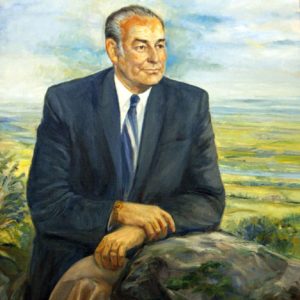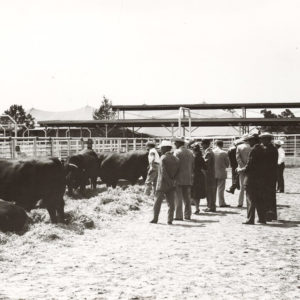calsfoundation@cals.org
Winrock Farms
As the brainchild of Winthrop Rockefeller, who was governor of Arkansas from 1967 to 1971, Winrock Farms holds a unique place in the history and culture of Arkansas, serving as a model facility to demonstrate agricultural practices as well as becoming a tourist destination. Since its founding in 1953, Winrock Farms, located on Petit Jean Mountain near Morrilton (Conway County), has been known for producing purebred Santa Gertrudis and Red Angus cattle. In addition, Winrock Grass Farm was created in 1955 to introduce a new type of turfgrass that was said to be ideal for cultivation in the Mid-America region.
Born in New York City to the wealthy Rockefeller family, Winthrop Rockefeller was the fifth of six children. He was the grandson of John D. Rockefeller, founder of Standard Oil. Winthrop’s male siblings—John D. Rockefeller III, Nelson Rockefeller, Laurance Rockefeller, and David Rockefeller—became involved with the family businesses, performing the kind of office work that held little interest for Winthrop.
Winthrop Rockefeller served with distinction in combat during World War II as part of the Seventy-Seventh Infantry Division in the Pacific. In 1953, after returning home to New York, he accepted an invitation to come to Arkansas for a visit with an army buddy, Frank Newell, a businessman in Little Rock (Pulaski County). During their time together, Rockefeller suggested that Newell come to New York to work with him in Rockefeller family enterprises, but Newell persuaded Rockefeller to consider settling in Arkansas instead.
At the time, Rockefeller was in the middle of a nasty divorce drama that eventually lasted four years. While visiting with Newell, a plan evolved for Rockefeller to leave New York for Arkansas in order to avoid the glare of the media. The original idea was for him to live in the capital city, while also purchasing a weekend retreat in a rural area of the state. However, when they found 927 acres of a worn-out cotton plantation on Petit Jean Mountain, about sixty miles from Little Rock, Rockefeller became enthusiastic about buying it to create a working cattle ranch there. As Winrock Farms, the land at Petit Jean also went on to become Rockefeller’s full-time home.
Rockefeller established the foundational elements of the ranch between 1953 and 1956 at a cost of about $2 million (equivalent to almost $20 million today). After the purchase of the initial 927-acre tract, Winrock Farms grew to 2,400 acres at the top of the mountain and another 4,500 acres in the valley below. Rockefeller transformed the woodland scrub into a model cattle-breeding operation, with Petit Jean becoming a top tourist attraction in the process. Some visitors were cattle ranchers interested in seeing new techniques, while others were members of the public who were curious about what one of the nation’s richest men had built in Arkansas.
Hundreds of jobs were created in the process of constructing Winrock Farms. Three miles of underground waterlines were installed, along with two miles of portable sprinkler pipes to keep the grazing pastures irrigated and green. Thousands of tons of rock were moved to build walls or crushed to use as roads around the farm. Along with a spacious, rustic-style home, outbuildings included several large barns, two silos to hold feed, corrals with iron fences to contain the cattle, stables for horses, and a professionally equipped garage and machine shop. There were administrative offices, a firehouse and fire engine, a laundry, a locker room with showers for farm workers, and underground storage for thousands of gallons of gasoline. In addition, Winrock Farms had its own airfield with a hangar, a waiting room, and a 4,600-foot lighted runway that could accommodate a four-engine jet plane.
Soon after he purchased the land in 1953, Rockefeller brought in a herd of Santa Gertrudis cattle from the King Ranch in Texas. Its showpiece bull was called “Rock.” From that beginning, he sought to create a model farm and livestock center to demonstrate successful agricultural practices that other farmers could adopt.
In addition to the cattle operation, Winrock Grass Farm was created in 1955. The grass farm introduced a new type of turfgrass that was said to be superior to other grasses and was ideal for cultivation in the mid-America region. Zoysia grass in particular became a favorite for use on athletic fields, golf courses, and public parks, becoming popularly known as “Winrock Zoysia.” Winrock Grass Farm worked with leading golf course designers such as Jack Nicklaus, Arnold Palmer, and Robert Trent Jones. Following Rockefeller’s death, Winrock Grass Farm was incorporated under new ownership.
When Rockefeller died in 1973 at the age of sixty, his body was cremated and his ashes were interred at Winrock Farms. Not long after Rockefeller died, Winrock Farms was split into the cattle operation and a philanthropic effort called Winrock International. In the twenty-first century, the Winrock International Research and Training Center at Petit Jean continues his vision for livestock research and rural development. It is located at the Rockefeller homestead on 188 acres of the original grounds of Winrock Farms. The mission of this nonprofit organization is to continue Rockefeller’s legacy by offering conferences and special events designed to help improve people’s lives.
For additional information:
Kirk, John. “The Prelude to Winthrop Rockefeller’s Rise in Arkansas.” Arkansas Times, March 7, 2022. https://arktimes.com/news/history-news/2022/03/07/the-prelude-to-winthrop-rockefellers-rise-in-arkansas (accessed April 2, 2023).
———. Winthrop Rockefeller: From New Yorker to Arkansawyer. Fayetteville: University of Arkansas Press, 2022.
Winrock Grass Farm Inc. https://www.winrockgrassfarm.com/ (accessed September 28, 2023).
Winrock International. https://winrock.org/ (accessed September 28, 2023).
Nancy Hendricks
Garland County Historical Society
 Agriculture
Agriculture Business, Commerce, and Industry
Business, Commerce, and Industry Winthrop Rockefeller
Winthrop Rockefeller  Winrock Farms
Winrock Farms 




Comments
No comments on this entry yet.